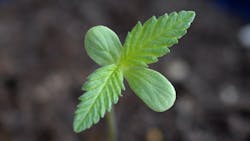In indoor cannabis growing, the relatively lengthy time period in which the plant stretches from seedling into stem and leaf is the one that requires the longest exposure to artificial light. Now, researchers are investigating eliminating that phase in order to slash energy costs.
A team from vendor Fluence Bioengineering and Dutch contract research group Innexo BV is expanding a small-scale experiment at Innexo’s Meterik facilities in which they have taken cannabis straight from seedling to the flowering phase, skipping what’s known as the vegetative stage.
Austin, Texas–based Fluence and Innexo claim that early results have shown an average of 40% lower electrical costs from reductions in lighting and HVAC, and that those savings could hit 55%. The team has tested what they call the “no-veg” approach on six cannabis cultivars and 10 nutrient lines while deploying varying light intensities.
The partners will now “collaborate on a full-scale research project to validate these initial results,” they said in a press release.
Loosely speaking, cannabis’ vegetative stage can last for up to 8 weeks — Fluence and Innexo said it’s typically 1–4 weeks in a commercial setting. During that time, some growers expose the plant to light for most of the day — roughly 18 hours, with 6 hours of darkness, according to various sources.
Flowering, which can also be an 8-week period (4 weeks in the Fluence/Innexo no-veg trial), typically requires less light exposure compared to the vegetation period, or about 12 hours of light daily, although the intensities might vary from vegetative.
The vegetative stage generally gives cannabis plants the strength to support the later flowering.
Fluence/Innexo did not explain how they were able to do without this aspect. But they insisted that the results speak for themselves on the basis of energy savings and other benefits.
“Fluence and Innexo’s research uncovered potential savings for growers who pursue growing without a vegetative phase, including an average of both 40% lower electrical costs and up to 40% lower labor costs per crop cycle,” they noted. “Because of the fast-paced growth of the plants, researchers found there was less time for pests and diseases to develop, leading to a healthier end product. In addition, this method could reduce waste by eliminating C-Grade flower, which allows for more crop cycles per year and increases overall predictability for growers.”
The group based its findings on eliminating two weeks of vegetative growing, or 252 hours at what would have been 18 hours per day.
“When the plants would typically enter the vegetative phase, they were instead transplanted to the flowering room, where they immediately received their maximum light intensity,” Fluence/Innexo said. “In this system, cannabis crops reach their final height — between 70 and 120 cm [between approximately 2.3 feet and 3.9 feet] — around 28 days after transplant.”
Their early findings suggest that no-veg growing is most effective at plant densities of between eight and 10 plants per square meter (about 10.8 square feet).
Fluence is a division of Eindhoven, Holland–based Signify, and is one of two horticultural groups at the lighting giant, the other being the Horticulture LED Solutions Group based in Eindhoven.
Innexo is one of seven groups within Meterik-based Botany Group, a private horticultural research outfit. Innexo focuses on medicinal plants such as cannabis.
Fluence and Innexo have worked together on cannabis research since October 2022. Last year they added a program to work with small growers, called the Acceleration Platform for Innovation (API).
In other horticultural news...
Canadian grower trialing far-red LEDs on mini cucumbers
Far-red: The great pretender that can help your crops
Bay Area cannabis grower increases yields with LEDs
MARK HALPER is a contributing editor for LEDs Magazine, and an energy, technology, and business journalist ([email protected]).
Follow our LinkedIn page for our latest news updates, contributed articles, and commentary, and our Facebook page for events announcements and more. You can also find us on the X platform.





